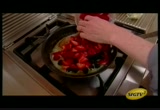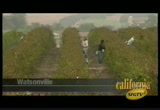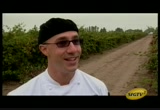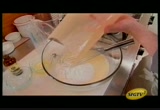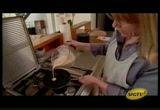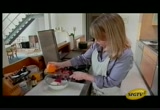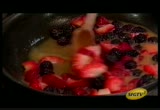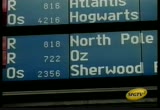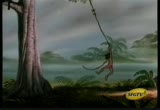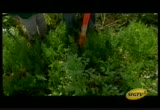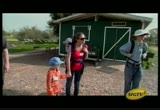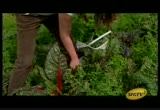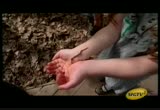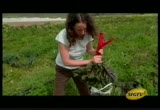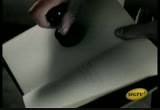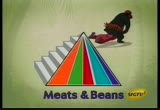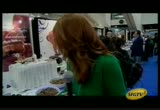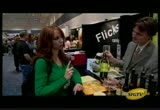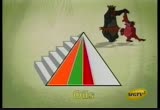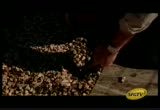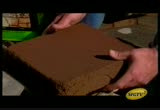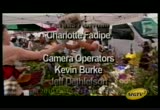tv [untitled] September 1, 2010 9:00am-9:30am PST
10:01 am
>> coming up on "california country," find out the secret to making these great desserts. and here's a hint they're berry, berry tasty. >> so, i have strawberries and blackberries and raspberries. and you can use any combination. >> next, these kids are proving you're never too young to learn about farming or to get your hands a little dirty along the way, too. >> get yourself a handful. >> ah. >> and look what we have-- carrots. >> then, if you like food, there's only one place to go. so, i have traveled all over this entire show looking for one product, and i found it-- chocolate bacon. get your appetites ready, because "california country" starts now. [captioning made possible by california farm bureau federation]
10:02 am
they're flavorful. they're colorful. and these days, you just never know where fresh california berries will turn up next. a beacon of springtime and warmer weather on the horizon, fresh california berries of every shape, size, and color are in high demand this time of year. and many of them start here along the central coast of california, where the cool coastal climate mixed with the rich soil, dedicated farmers, and skilled workers, and the perfect recipe for success is formulated. and for naturipe farmer tom amrhein, growing the little berries requires a lot of big work throughout the year. >> and so, there's that whole process of handpicking them. but then there's also the process of pruning and taking care of each individual plant that goes on. so, it's tremendously labor intensive. >> but at tom's watsonville farm, blackberries actually reign supreme these days.
10:03 am
he says when choosing them, look for deep, evenly colored berries with a nice sheen. they should be plump and dry and shouldn't have many dents or bruises. >> blackberries are made up of something called drooplets, which these individual little--i guess you would call them cells. and there's a seed in each one of those. and that's kind of characteristic of a blackberry. >> in addition to farming, tom believes in connecting foodies with farmers like himself by giving tours to folks interested in what it takes to get produce from the farm to their forks. on this tour, tom shows food industry professionals from all over the cntry as well as chefs and students from the culinary institute of america what a day in the life of a farmer is all about. >> first off, for those of us who buy produce in the supermarkets, to get out into the fields and see what really happens is fascinating. >> as a chef, understanding the ingredients just makes you a better cook, 'cause you understand where it comes from and then what its functionality is--not just flavor but texture and where it's from. and i think
10:04 am
it's why we have some students here from the culinary institute of america, is so they respect what they're using. >> someone who understands the complexities involved with growing produce is chef ressul rassallat from the nearby and world-renowned pebble beach golf course and resort. as you might guess, his diners are particularly discerning, being accustomed to only the best food being served to them. and while working in such a prestigious restaurant does have its challenges, it does have its advantages, too--mainly access to the bounty of local produce that is all around them. >> i can call the farmer and ask him to get me these berries. next day or maybe same day, later afternoon, they bring it to your door. and yoknow that you're gonna have to work so much hard for it and just provide it to clientele, and they realize the best berries yoever have. >> chef ressul calls fresh california-grown berries a healthy indulgence and one that he can't get enough of. from his 4-berry gelee to his raspberry souffle, berries are
10:05 am
cared for as delicately in the kitchen as they are out in the fields. >> we want that the customer knows that we are protecting the agriculture of here and the farmers, they're growing these berries and the vegetables, of course. and, uh, we don't have to reach for far. >> it's probably one of the most noble things to do, is to feed somebody and nurture their body. and so, knowing qhere the food comes from is really important. it connects the whole thing. [music playing] >> for "california country," i'm tracy sellers. >> hi. i'm emily luchetti, the executive pastry chef at farallon and waterbar restaurants. but today, i'm at home. and i'm gonna show you how to make some crepes that you can serve with beautiful summer berries. the first thing we're gonna do is make
10:06 am
the crepes. we have 2 eggs. now i'm just adding some regular milk. if you wanted to use 2 1/2% milk, you could. and then we're gonna add a little bit of water, 'cause that helps make the crepes a little bit thinner. and then we're gonna add a combination of flour, cornstarch, and a little pinch of salt. and i like to use cornstarch instead of just all flour, because it helps make the crepes just a little bit thinner and lighter. and we're just gonna whisk that together. you want to whisk it pretty vigorously, because you want it to be nice and smooth. some people will put it in a blender, but i don't usually do that 'cause i don't like cleaning out the blender. [chuckles] so, we're just gonna whisk this till it gets nice and smooth. and then we're gonna add a little bit of vanilla, just a half a teaspoon of vanilla extract... and some melted butter. now, this crepe batter you could
10:07 am
actually make several days ahead and just let it sit in the refrigerator. when we're doing crepes at one of the restaurants, we'll make a big vat of it. and that way, you don't have to make it so often. and just whenever you want to make a few fresh crepes, just pull it out, and you're ready to go. now, to make the crepes, i like to use a teflon pan. you can find the praditional french crepe pans all over the place, but i think these work a lot better. and what you're gonna do is just take a little bit of that crepe mixture and pour it in the pan. and as you're pouring, swirl it around so you get a nice thin mixture on the boom. and if you find that you've put too much in, just take the pan and just turn it upside down and let the extra batter fall back into the original container. and then when you're ready to flip the crepe, you can either take a small offset spatula or a knife and just lift it out to your fingers and then just flip it over like that. now that i've finished making all these gorgeous crepes, we're gonna make the filling for
10:08 am
the crepes, and then we're gonna make dhe sauce. so, what we're gonna do for the filling is, i have some ricotta cheese here. and we're gonna put some sugar in. and that'just a little bit to take the edge off of the tartness of the cheese. d then i'm gonna add a little bit of vanilla, just a half a teaspoon. and then we're gonna add some orange zest. and this is a microplaner here. so, it takes the orange and just grates it. and you don't need the whole orange, 'cause these oranges are pretty big. so, that just gives it a little bit of orange flavor. and qe're gonna mix those together. and you could also use fromage blanc. you could use cream cheese. you could really use any kind of cheese or anything that's thick that you wanted to. so, now that that's all put together, we're gonna take 2 of our crepes... and put them right here. and we're just gonna take a little bit of the ricotta mixture.
10:09 am
you don't need much. just put it in there. and then i'm gonna fold them up into a square. and then you're gonna turn them over seam side down so they will stay up. so, here's the pan. and i'm gonna go ahead and add some orange juice. [sizzling] and you want that nice and hot, because you want the juice to really be able to reduce. and depending on the orange juice, if it's really sweet, you don't have to add any sugar at all. if you taste it and it's a little bit tart, add a tablespoon of sugar. but i've tried this, and it's delicious as the way that it is. and now i'm gonna get this wooden spoon, and i'm gonna actually add some butter. and we're gonna stir that in. now, you want that butter to melt dowlike this before you add your berries, because you want the sauce to reduce a little bit. and if you add
10:10 am
the berries too soon, they're just going to break apart. so, we probably don't need all these berries. so, i have strawberries and blackberries and raspberries. and you can use any combination of berries that you want or that you have. and you just want to cook this through gently until they're nice and warm. you don't want to cook them so far that they break apart. so, now that the sauce is ready, i'm just gonna take a spoon, and we're just going to ladle on some berries. and i've used a slotted spoon because i don't want too much juice to get on there. but you want to get all the berries. and then you can just take your pan and just pour... a little bit there. so, there you go. now, this is a dessert that you have to serve right away. but serving right away means eating right away.
10:11 am
10:12 am
>> it's one thing to buy things in boxes and packages and just have it show up. it's another thing to actually know where that is produced and where it's come from and how it's produced. i think that even goes further when you have some kind of personal connection to it. >> welcome back to "california country," the show that takes you on an all-expense-paid trip to experience the best-kept secrets
10:13 am
of the golden state. [jazz music playing] >> for dozens of northern california kids, it's a rare chance to get their hands in the soil and become young farmers r a day, harvesting vegetables like broccoli and fresh carrots. >> i'll loosen some soil, and you guys can come through and pull the carrots up and see what you get. so, we just kind of take the fork, bury it in the ground. you can just pop the carrots up a little bit. and then... get yourself a handful. >> ah. >> and look what we have. [indistinct chattering] [jazz music continues] >> we've found that, you know, if children in particular can kind of touch and feel it, if they can help put seeds in the ground, then they're gonna put that stuff in their body. and that's--for me, look at all the stuff that's going on in the world right now around health. it's like, that's a good sign to me.
10:14 am
>> ok, so the little hands did have some help from adults who help to run soil born farms in sacramento county. >> we've been farming in sacramento county for almost 10 years now. this is our third year producing food out here at the american river ranch. it's about a 25-acre lease that we have through sacramento county. so, i say we take a stroll on down to the field and see if we can get our hands dirty and see what's growing. [indistinct chattering] >> so, does anybody know... what is growing right here? does anybody know what this is? >> a beet. >> it's a beet. indeed, it is. it's actually chard. so, chard is one of those greens that we can plant this crop in the fall, get a harvest all through the winter and into the spring before it'll go up and flower and we'll have to replant. >> i like just the who concept of being able to create
10:15 am
something and then to know that my energy, that the energy that i'm putting to my work is gonna improve somebody's life. >> soil born farms is a nonprofit organization. for the last 3 years, staff have been farming these 25 acres within the american river parkway. this land actually dates back to the 1800s and originally belonged to william leidesdorff, america's first african-american millionaire. >> yeah. he owned it for about 10 years and actually did some production on the property even back then for a lot of the mining calps and stuff like that. >> shawn harrison helped to start soil born farms about a decade ago and says for many urban kids, this is the first chance they've had to go into a chicken coop to see roosters, hens, and some fresh california eggs, not to mention an up-close
10:16 am
encounter with the farm's mascot, a potbellied pig called whiskey. >> he's a potbellied pig. and he is older than soil born being here. he's been here since before we were here farming. >> after all that, it was time to get hands dirty again and learn about vermiculture-- that a fancy term for composting with worms. these little wrigglers were a big hit with the kids. but at first, they're like, "wow, this is"-- >> "wow." it's, like, foreign. they're just blown away by the-- you know, they're amazed. >> he believes that showing urban kids at an early age that farming can be fun is not difficult. and it's a great way to invest in the future generation of california farmers. >> it was fun. a lot of times,
10:17 am
when i was trying to pull it out, i would just rip off the leaves and stem. and then there would just be that carrot there. i was surprised how hard it was to pull it out. >> you know, out of all of the human history, right--we've been around for a long time-- i mean, this is really--this generation, these kids today, are really the most far removed from food that we've ever been from. we've coevolved with agriculture. and, you know, i think creating opptunities to do some reconnection is gonna have profound implications. that's who we are. you know? >> in sacramento, charlotte fadipe, "california country" tv. >> this segment is brought to you by the california farm bureau federation. we'll be right back with more of the magical creations from california's most famous
10:18 am
10:19 am
when you have some kind of personal connection to it. >> literally farm to table. literally, it's, like, from the garden. it's from the dirt. i mean, they come straight from that place. when you make that connection with the farmer, with the growers, it makes for a different feeling when you're cooking. for me, now things taste different. >> welcome back to "california country." >> so, we're at the fancy food show. and this year, i came prepared. i've got comfortable
10:20 am
shoes. i've got my own eating utensil. and most of all, i've got a hungry stomach. so, let's go. [music playing] mmm. light, salty. [laughing] [indistinct chattering] >> mmm. we're gonna go see some old friends. let's see if they recognize me. >> would you like to try some cinnamon-- >> we will, yes. we just want to talk to mike and mike here. >> of course. >> hey! >> hey! how are you? >> i'm good. >> good to see you! >> good to see you. >> he recognizes us. yay! >> it's been forever. >> yes! how are you? >> i couldn't forget you. >> [chuckling] it's a good answer. od answer. could we do another taste test? >> sure. [music playing] here, try that one.
10:21 am
that's an almond. >> [chuckling] i got that part, mike. thank you. >> ha ha ha! >> maybe orange? >> no. >> see? i couldn't get... >> no. none. no chance at all she'll get this right. heh heh heh! >> the audience--if we could get some applause from the audience, i'd feel better about that. ok. [cheering and applause] >> yeah. >> mmm. it's a nut. >> yeah. >> it's a nut. >> that's good. we're on the right--yup. >> it's a nut. and i've got--butter? maybe some sort of butter? >> no. close, maybe. >> what is it? >> irish cream. see? >> that's the one that got me last time, i think, too. >> the cream-- >> you know, i should know the alcoholic nut. >> yeah. >> well, the fancy food show is an opportunity for lots of different suppliers. we have 1,300 companies here who are showing everything from caviar to smoked salmon to--even smoked olive oil is here this year, which i've never heard of before. so, they all come here. they show all their products to the buyers. and we're expecting
10:22 am
about 17,000 buyers to come from restaurants, from retail stores, from gift shops--you know, from almost everywhere around. so, they're coming in, trying great foods. and the things that's good about this is, these foods can be in your stores in a matter of a couple of weeks. >> so, i have traveled all over this entire show looking for one product, and i found it-- chocolate bacon. wh-what else do you need in a fancy food show, right? so, let's try some here. it's this. salty...sweet... very good. tastes like bacon. [chuckles] [indistinct chattering] >> it tastes better when someone's feeding it to you. >> oh, does it? >> mm-hmm. so, look who we ran into--our friend mari. how are you, mari? >> i'm doing wonderful. it's been a fabulous show. >> good. what new products do you have for us? >> well, we're sharing our new zip-lock packaging, our special
10:23 am
closure here-- >> oh. >> with our fabulous blenheim dried apricots. >> people are really rediscovering the apricot, right? >> yes, they are. it's unfortunate that we've lost so many of these wonderful stone fruits here in california. and with our hundred acres, it's a very nice response from the area and from all the other countries that are looking for this product. >> so, what do we have here? what makes this product so special? >> it's made actually from vineyard grapes, which is different than table grapes. and we make this right here in the napa valley. and as the vineyard grows, having more difficult time selling the grapes to the winemakers, this is an alternative for the wine industry to create something that is another outlet. >> virgin grape juice--ok. >> yes. that means it's not fermented. it's absolutely pure. >> ooh. that's good. so, there are hundreds of different booths and things to see here, but this place caught
10:24 am
our attention. i'm gonna let you guess one reason why-- the name. what is with the name? what does the name mean? hi! >> you ever hear of ingamajig? >> [chuckling] i have now. what is it? >> it's figs. it's figamajig. it's a fig candy and--mixed with cocoa with a little dark chocolate on the outside. [music playing] >> and with a product like yours, don't you find that people want to know where their food's coming from more than ever? >> definitely. and, you know, california--we've gotta suprt california. we have to support the growers and the workers. it's just so important. >> well, one of the reasons the industry has done well over the past few months--because people are eating out less in restaurants. so, people are going to cooking at home, and they're finding out that they enjoy cooking at home. you know, and we think that that's gonna continue even as the economy gets better. we think people are enjoying being home with their friends and their family and, you know, making a nice dinner. and i think that will be continuing. [music playing]
10:26 am
10:27 am
for every gardener--hardscape. think about overcoming drought or weeds. so many options, too-- there's decorative stone, there's flagstone, and there's pavers. let's start with the most inexpensive and easy topic, and that's decorative stone. look at this beautiful cal gold or this ginger or dolomite, all made of stones from california. one thing i always mention to people--don't forget the weed fabric. 2 or 3 inches down, this will prevent you from overcoming your garden with lots and lots and lots of weeds. as a new lawn decorative stone, there's also flagstone, available in so many colors. it's got endless applications. here you can see some beautiful sandstone. this is a three rivers tumble--or this quartzite. avilable these days is even veneer stone, cut to fit right on the side of your home or a hearth--lots an lots of applications. and with some easy tools, some mortar, and some concrete, and a sponge, it's easy to install.
10:28 am
the next hardscape is pavers--real popular. think about that old concrete driveway that you can put over with something beautiful like this. textured and available in a lot of different colors, the pigment goes down quite a bit, lasting up to 50 years or more. something that's really become popular is this adobe block used for retaining walls or also on patios. it's a native material-- really cool stuff. think about either sealing stone or even a lacquer to give your hdscape a wet look and finish. really cool. the last topic would be boulders. they never need water, and boy, they're living and breathing. this case--look at this golden brown granite. think about it on a corner in front of your home. this is a really cool edition to completing your garden. how about this moss rock? look at all those lichen. this is really cool. available in as big as 8 ton,
10:29 am
this thing will go a long way in your landscape. remember, california is a real dry state. so, when you incorporate hardscaping into your landscape, it'll save you money and it'll save the environment. and you won't have the weeds to deal with. let's get gardening! >> that concludes today's tour of the best of "california country." join us next time for more undiscovered treasures from the most fascinating state in the country. [captioning made possible by california farm bureau federation] [captioned by the national captioning institute --www.ncicap.org--]
95 Views
IN COLLECTIONS
SFGTV2: San Francisco Government Television Television Archive
Television Archive  Television Archive News Search Service
Television Archive News Search Service 
Uploaded by TV Archive on

 Live Music Archive
Live Music Archive Librivox Free Audio
Librivox Free Audio Metropolitan Museum
Metropolitan Museum Cleveland Museum of Art
Cleveland Museum of Art Internet Arcade
Internet Arcade Console Living Room
Console Living Room Books to Borrow
Books to Borrow Open Library
Open Library TV News
TV News Understanding 9/11
Understanding 9/11
